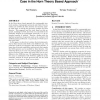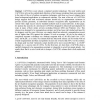CCS
2008
ACM
14 years 2 months ago
2008
ACM
In the Horn theory based approach for cryptographic protocol analysis, cryptographic protocols and (Dolev-Yao) intruders are modeled by Horn theories and security analysis boils d...
CCS
2008
ACM
14 years 2 months ago
2008
ACM
CCS
2008
ACM
14 years 2 months ago
2008
ACM
In 1998, Blaze, Bleumer, and Strauss suggested a cryptographic primitive termed proxy re-signature in which a proxy transforms a signature computed under Alice's secret key in...
CCS
2008
ACM
14 years 2 months ago
2008
ACM
Correct enforcement of authorization policies is a difficult task, especially for multi-threaded software. Even in carefully-reviewed code, unauthorized access may be possible in ...
CCS
2008
ACM
14 years 2 months ago
2008
ACM
A traitor tracing system enables a publisher to trace a pirate decryption box to one of the secret keys used to create the box. We present a traitor tracing system where ciphertex...
CCS
2008
ACM
14 years 2 months ago
2008
ACM
Reflective Database Access Control (RDBAC) is a model in which a database privilege is expressed as a database query itself, rather than as a static privilege contained in an acce...
CCS
2008
ACM
14 years 2 months ago
2008
ACM
BootJacker is a proof-of-concept attack tool which demonstrates that authentication mechanisms employed by an operating system can be bypassed by obtaining physical access and sim...
CCS
2008
ACM
14 years 2 months ago
2008
ACM
Harvard architecture CPU design is common in the embedded world. Examples of Harvard-based architecture devices are the Mica family of wireless sensors. Mica motes have limited me...
CCS
2008
ACM
14 years 2 months ago
2008
ACM
Rootkits are now prevalent in the wild. Users affected by rootkits are subject to the abuse of their data and resources, often unknowingly. Such malware becomes even more dangerou...
CCS
2008
ACM
14 years 2 months ago
2008
ACM
By functionally decomposing a specific algorithm (the hierarchical secure aggregation algorithm of Chan et al. [3] and Frikken et al. [7]), we uncover a useful general functionali...





